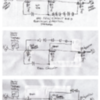I have a MRC Pure Power Dual handle 270W transformer, where I was only getting 7V max output on one side of the transformer. Put a scope on the 7V side and only saw the bottom side of the sine wave. I pulled the cover and there was a circuit board with two rows of 6A10 diodes with 6 diodes in each row (each handle on the transformer has a circuit board with 12 diodes). On the 7V side, one row of the 6A10 diodes, had a bad diode and another had come disconnected from the circuit board. I replaced & resoldered the diodes and all is well now and I am getting the full 19V output.
If someone could explain:
-Why is the 19V AC output of the transformer affected by the bad diodes?
-Aren’t the diodes used for whistle & horn functions?
-Why are twelve 6-amp diodes needed? My old ZW has one diode.
Appreciate the education on this topic.
Thanks,
RAD400






